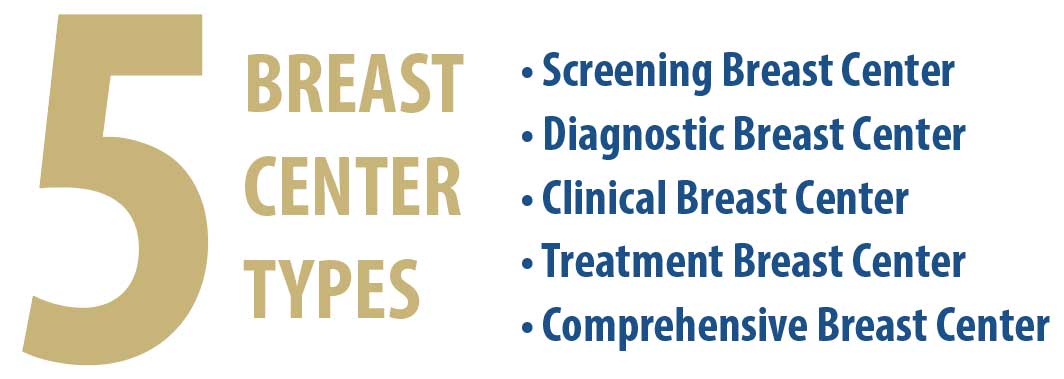
A breast center type, for the purposes of certification, is identified by the components that the center “provides” with “quality control.” The NQMBC® program wants to make sure the center has control over the behavior to improve quality performance, thus the NQMBC® program considers only “provided” services when considering a breast center’s type for certification.
Service components not “provided” but offered to patients through the center may be “referred” service components. This means that the center does not have “quality control” of those services but offers these services to patients.
Number and Percentage of Measures Required for Certification Levels by Breast Center Levels
| Certification Levels | |||||
|---|---|---|---|---|---|
| Participant | Certified Participant | Certified Quality Breast Center™ | Certified Quality Breast Center of Excellence™ | ||
| Breast Center Type | # of measures per profile | Entered Data for at least one measure | Must report 40% of measures | Must report 75% of measures | Must report 90% of measures |
| Screening Breast Center | 6 | 1 | 2 | 5 | 5 |
| Diagnostic Breast Center | 9 | 1 | 4 | 7 | 8 |
| Clinical Breast Center | 25 | 1 | 10 | 19 | 23 |
| Treatment or Comphrehensive Breast Center | 45 | 1 | 18 | 34 | 41 |
Data Submission
Provide Data with the “Click of a Button”
Measuring and comparing quality performance is very effective in assessing patient care and allocating resources where improvement is desired; however, the process can be very time consuming on a center’s already overworked staff. To help centers measure quality performance and minimize staff time in gathering data points and calculating a center’s performance, several tracking software companies have taken the lead to adapt their software to analyze data and calculate the performance for measures. NCBC is working with mammography tracking software vendors to make the data collection much easier for our members. The leadership taken by these companies will allow their clients to produce quality measure responses with the touch of a button using their software.
Breast Center Types
Breast centers vary in many ways. The NQMBC™ Program classifies breast centers using two main variables: breast center profile characteristics and “provided” components of services.
Breast centers vary in many ways. The NQMBC™ Program classifies breast centers using two main variables: breast center profile characteristics and “provided” components of services.
The NQMBC™ Program offers breast centers the opportunity to evaluate themselves through the quality of the components of service they “provide.” The NQMBC™ Program does not ask for personal information such as financial data or specific numbers of patients seen by each clinician. The program asks for a snapshot of the characteristics of care being provided.
For an off-site surgeon who is not a direct employee of the breast center, the data question might be, “What is your surgical re-excision rate (%) for the last 30 breast cancer patients?” Or an oncologist might be asked, “What percent (%) of breast cancer patients seen with stage 2 breast cancer under the age of 70 have been offered chemotherapy in the last three months?” This type of data should be shared with the breast center in order for the center to claim they “provide” surgery and oncology components of service.
The center must also have “quality control” of that service. That means if the answers to these sample questions suggest a modification of the provided service is needed, the center has influence on changing the service. This doesn’t mean complete control of that component of service but the ability to modify it. In this example, the surgeon or oncologist would consider the breast center’s input when evaluating the answers to these sample questions. That means the center has both quantitative data and direct ability to modify the quality of that component of service.
Using this the type of breast care data and feedback creates an environment of quality improvement. This promotes our idea of interdisciplinary care. After these two variables have been defined, breast centers can be separated into five types:
- Screening Breast Center
- Diagnostic Breast Center
- Clinical Breast Center
- Treatment Breast Center
- Comprehensive Breast Center
A breast center type, for the purposes of certification, is identified by the components that the center “provides” with “quality control.” The NQMBC™ Program wants to make sure the center has control over the behavior to improve quality performance, thus the NQMBC™ Program considers only “provided” services when considering a breast center’s type for certification.
Service components not “provided” but offered to patients through the center may be “referred” service components. This means that the center does not have “quality control” of those services but offers these services to patients.
“Referred” AND “provided” services identify the type of breast center as viewed by patients and the public. Seamless care, not “quality control” is the factor for this center type identification.
Having “referred” service components does not impact the designation of type of breast center. Only “provided” services count towards defining the type of breast center for NQMBC™ certification consideration.
